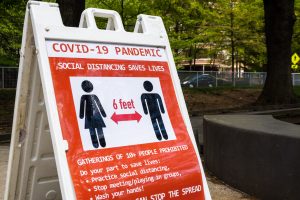37 N America: Medical Geography I –
A Brief Look at the COVID Pandemic
This chapter comments on the early days of the COVID epidemic. Of course, there has been a plethora of information on this topic since that time. The circumstances of COVID-19 were anthropologically and geographically striking from the beginning. Spread of the disease has not produced a randomized pattern, but instead has affected Americans differently based on location and on social, racial, and ethnic patterns.
Throughout the country, governors issued stay at home restrictions and other strategies of mitigation, including public health responses that involve testing and contact tracing, quarantining, and treating the infected. It is shocking to know that early in the pandemic we had more Americans die in a little over two months than we lost in Viet Nam (58,000) and the Korean War (36,000) combined.
Due to the ease of infection in places of high population density, early hot spots were Los Angeles, San Francisco, and Seattle on the west coast and New York City, New Jersey, and Boston on the east coast. New Orleans became a hot spot after the Mardi Gras festival. Detroit and Chicago were hot spots in the Midwest.

The strength in the US response has been its governors and local leaders across most of the nation. New York (Governor Chris Cuomo), California (Gavin Newsom), Washington (Jay Inslee), Michigan (Gretchen Whitmer), and Illinois (J. B. Pritzker) are but a few examples of governors and local leaders who let science be the primary reference when addressing their constituents.
Other states took less scientific approaches. Officials in Georgia manipulated statistics to fraudulently report improvement in COVD-19 cases over time. Federal leadership also chose to avoid science when it contradicted their personal hopes for better news. President Trump fired the Health and Human Services Inspector General Christi Grimm after she issued a report observing the shortage of protective personal equipment (PPE) to properly respond to this pandemic. Scientist Dr. Nancy Messonnier of CDC was demoted after alerting the public that the upcoming pandemic would disrupt our lives. Whistle-blower scientist Dr. Rick Bright who headed BARDA, the division in CDC responsible for developing vaccines, was demoted after he would not recommend hydroxychloroquine, as otherwise touted by President Trump for treating COVID-19. Silencing and ignoring the advice of Dr. Anthony Fauci, Dr. Deborah Birx, and the CDC left the public with misleading and incomplete information.
The impact of the virus socially, demographically, and economically has varied. African Americans, Latinx, and Native Americans have been the hardest impacted communities. They are more likely to live in urban centers or where there is considerable dense population, thus in settings where this virus more easily spreads. They are at increased risk for being underinsured and malnourished than white Americans are. This impact is tied to the socio-economic inequalities that exist within these communities. Health disparities among these minority populations, such as greater rates of pre-existing conditions like high blood pressure, heart disease, diabetes and obesity, put these populations at increased risk of experiencing complications from COVID-19. Individuals who are 65 and older are among the groups with the highest rates of mortality from the virus.

Economically we find that African Americans, Latinx, and Native Americans are more likely to be defined as essential workers who are not allowed to work remotely from their homes, but need to work on site. These workers are disproportionately people of color and immigrants. Smithfield Foods in Sioux Falls, South Dakota, is one such meat factory that had a noteworthy outbreak of COVID-19. Concerned about maintaining the supply of meat across America, on April 29, 2020, President Trump issued an executive order citing the Defense Act of 1950 to keep meat processing plants open to delay possible shortages of beef, pork, chicken and other meats. Oddly, President Trump did not use this act to increase production of personal protective equipment (PPE) for essential workers.
 Working on the disassembly-line these workers are in close quarters, practically shoulder to shoulder from each other preventing them from socially distancing. Needed masks would be hard to wear for long periods given the strenuous fast-paced nature of their work. Consequently, meat processing plants have been among the vectors for transmitting the COVID-19 virus.
Working on the disassembly-line these workers are in close quarters, practically shoulder to shoulder from each other preventing them from socially distancing. Needed masks would be hard to wear for long periods given the strenuous fast-paced nature of their work. Consequently, meat processing plants have been among the vectors for transmitting the COVID-19 virus.
The close proximity in which individuals live and work can easily prompt the spread of COVID-19. A number of nursing homes across the country have reported numerous deaths, while prisons, such as in Marion, Ohio, and in Pine Bluff, Arkansas, face challenges to halt the virus. For a look at which jobs place workers at greater risks, examine the excellent diagram at https://www.visualcapitalist.com/wp-content/uploads/2020/04/covid-19-occupational-risk-scores.html
Federal, state, and local governments continue to search for ways to balance the health and economic challenges. International comparisons are interesting and perhaps a topic for an additional essay. Countries that have been better in effectively controlling the COVID-19 threat have done so be demonstrating strong political leadership that stresses science in response to this pandemic. Examples include New Zealand – Prime Minister Jacinda Ardern – population of 4.8 million, Germany – Chancellor Angela Merkel – 83.0 million, South Korea – President Moon Jae-in – 51.6 million, and Taiwan – Tsai Ing-wen – 23.7 million.
Did You Know?
This 2020 version of this chapter was written by anthropologist Derrick Willis.
Cited and additional bibliography:
Armstrong, Martin. 2020. “Infographic: COVID-19 Cases per Million Inhabitants: A Comparison.” Statista Infographics. May 18, 2020. https://www.statista.com/chart/21176/covid-19-infection-density-in-countries-most-total-cases/.
Baird, Robert P. 2020. “What It Means to Contain and Mitigate the Coronavirus.” The New Yorker. March 11, 2020. https://www.newyorker.com/news/news-desk/what-it-means-to-contain-and-mitigate-the-coronavirus.
“COVID-19 May Not Discriminate Based on Race — but U.S. Health Care Does.” 2020. YouTube Video. YouTube. https://www.youtube.com/watch?v=U5QdRwflM9I&t=1s.
dmbosstone. 2020. COVID-19 Sign in Arlington County, Virginia. https://tinyurl.com/covidarlington. Attribution-NonCommercial-NoDerivs 2.0 Generic (CC BY-NC-ND 2.0).Laa, Jose Manuel de. n.d. Coronavirus by José Manuel de Laá from the Noun Project. Accessed May 30, 2020. https://thenounproject.com/search/?q=covid-19&i=3349759.
Lussenhop, Jessica. 2020. “The Untold Story behind America’s Biggest Outbreak.” BBC News, April 17, 2020, sec. US & Canada. https://www.bbc.com/news/world-us-canada-52311877.
Martin, Rachel. 2020. “Labor Reps Worry About Meatpackers Safety After Plants Ordered To Reopen.” NPR.Org. April 29, 2020. https://www.npr.org/2020/04/29/847732023/labor-reps-worry-about-meatpackers-safety-after-plants-ordered-to-reopen.
McCarthy, Ryan, and Sam Daniel. 2020. “Map: COVID-19 Meat Plant Closures.” Www.Meatpoultry.Com. May 28, 2020. https://www.meatpoultry.com/articles/22993-covid-19-meat-plant-map.
Molteni, Megan. 2020. “Why Meatpacking Plants Have Become Covid-19 Hot Spots.” Wired. May 7, 2020. https://www.wired.com/story/why-meatpacking-plants-have-become-covid-19-hot-spots/.
Petterson, Henrik, Byron Manley, and Sergio Hernandez. 2021. “Tracking Coronavirus’ Global Spread.” CNN. August 9, 2021. https://edition.cnn.com/interactive/2020/health/coronavirus-maps-and-cases/.
Press, Associated. 2020. “Georgia, Florida Accused of Fudging or Bungling COVID-19 Testing Data to Make State Look Better.” Www.Mywebtimes.Com. May 19, 2020. https://www.mywebtimes.com/2020/05/19/georgia-florida-accused-of-fudging-or-bungling-covid-19-testing-data-to-make-state-look-better/afix7zf/.
Rosner, David. 2010. “Spanish Flu or Whatever It Is …”: The Paradox of Public Health in a Time of Crisis.” Public Health Reports 125 (S3): 37–38.
Singer, Merrill. 1995. “Beyond the Ivory Tower: Critical Praxis in Medical Anthropology.” Medical Anthropology Quarterly 9 (1): 80–106.
“The Dangerous Global Flood of Misinformation Surrounding COVID-19.” 2020. YouTube Video. YouTube. https://www.youtube.com/watch?v=Xl9zgDGko5U.


